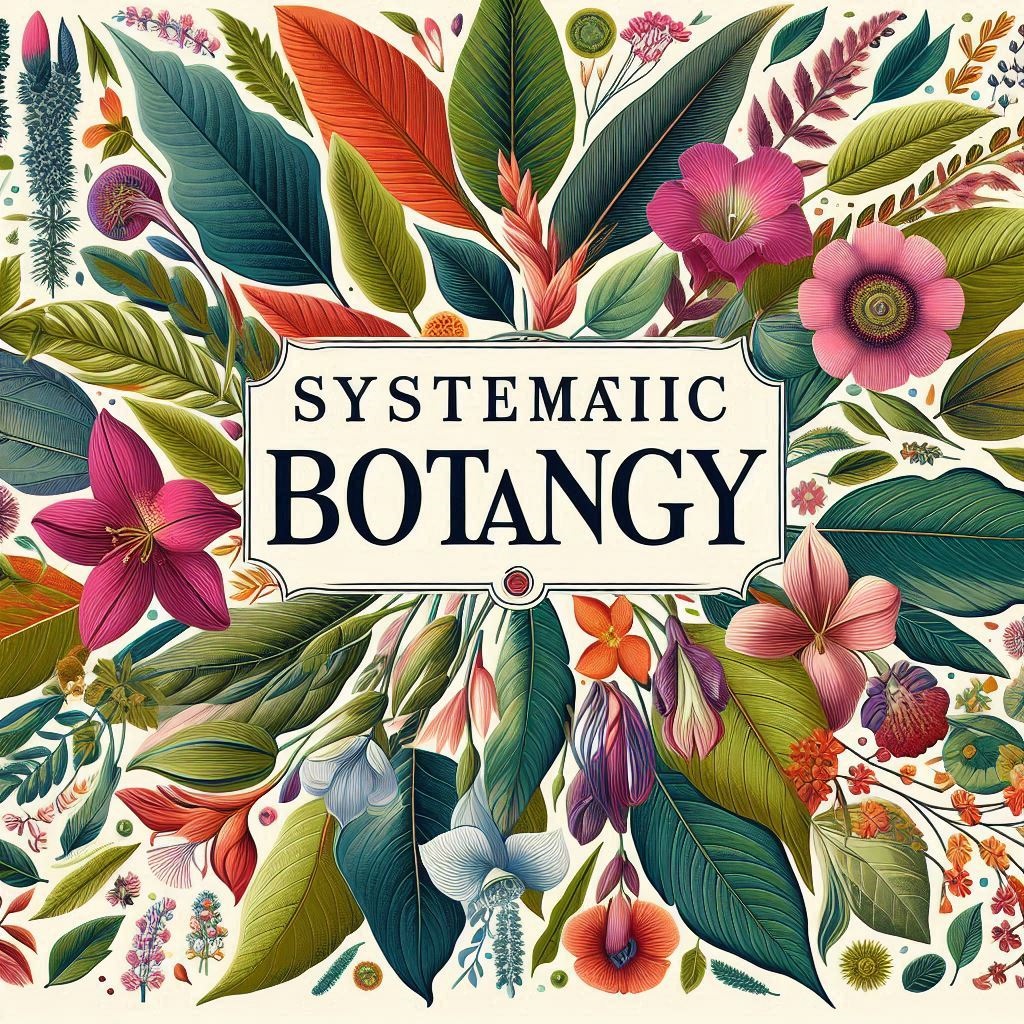Systematic Botany
Systematic botany, also known as plant systematics, is the scientific study of the diversity of plant life and the evolutionary relationships among plant species. It involves the classification, naming, and description of plants, as well as the investigation of their genetic, morphological, and ecological characteristics. This field plays a crucial role in understanding plant biodiversity, evolution, and conservation.
History and Development
The roots of systematic botany can be traced back to ancient civilizations, where early botanists like Theophrastus and Dioscorides documented plant species and their uses. However, the modern foundation of plant systematics was laid by Carl Linnaeus in the 18th century with his binomial nomenclature system. This system, which assigns each species a unique two-part Latin name, revolutionized plant classification and remains in use today.
Classification Systems
Classification systems in systematic botany have evolved over time. Early systems were primarily based on morphological characteristics, but advances in molecular biology have led to the incorporation of genetic data in classification. The most widely used modern system is the Angiosperm Phylogeny Group (APG) system, which relies on DNA sequence data to determine evolutionary relationships among flowering plants.

Methods in Systematic Botany
Systematic botany employs a variety of methods to study the diversity and evolutionary relationships of plants. These methods range from traditional morphological analysis to modern molecular techniques. Here are some of the key methods used in this field:
Morphological Analysis
Morphological analysis involves examining the physical characteristics of plants, such as leaves, flowers, fruits, and stems. This traditional approach is fundamental for identifying and classifying plants based on observable traits. Detailed morphological studies can reveal important evolutionary relationships and help in the description of new species.
Molecular Phylogenetics
Molecular phylogenetics uses DNA sequencing to study genetic relationships among plant species. By comparing DNA sequences, researchers can construct phylogenetic trees that illustrate evolutionary lineages. This method provides a more precise understanding of plant evolution and has revolutionized plant classification. For more information, visit NCBI.
Biogeography
Biogeography examines the geographic distribution of plant species. By studying where plants are found and how they spread over time, scientists can infer patterns of evolution and speciation. This method is particularly useful for understanding how historical events, such as continental drift and glaciation, have shaped plant diversity. Explore more about biogeography at Biogeography Society.
Herbarium Studies
Herbaria are collections of preserved plant specimens that serve as valuable references for taxonomic research. These specimens are meticulously documented and stored, providing a historical record of plant diversity. Herbarium studies involve examining these specimens to verify plant identities, study variations, and discover new species. Learn more about herbaria at Herbarium Information Network.
Cladistics
Cladistics is a method of classifying plants based on shared derived characteristics. It involves constructing cladograms, which are branching diagrams that represent evolutionary relationships. Cladistics helps in identifying monophyletic groups (clades) that share a common ancestor. This approach provides a systematic framework for understanding evolutionary history. Read more about cladistics at Cladistics Society.
Chromosome Analysis
Chromosome analysis, or cytogenetics, studies the number, structure, and behavior of chromosomes in plants. This method helps in identifying species, understanding genetic variations, and studying hybridization events. Chromosome analysis can reveal important insights into the genetic makeup and evolutionary processes of plants. For additional details, check out Chromosome Research Society.
Ecological and Environmental Data
Ecological studies involve analyzing the interactions between plants and their environments. Researchers collect data on habitat preferences, soil types, climate conditions, and ecological relationships. This information helps in understanding how environmental factors influence plant distribution and evolution. Discover more about ecological methods at Ecological Society of America.
Ethnobotany
Ethnobotany explores the relationships between people and plants. By studying traditional knowledge and uses of plants by indigenous cultures, ethnobotanists gain insights into plant diversity, conservation, and potential applications. This method bridges scientific research and cultural heritage, contributing to the preservation of both. Learn more about ethnobotany at Society for Ethnobotany.
Bioinformatics
Bioinformatics involves the use of computational tools to manage and analyze large datasets, such as DNA sequences and morphological data. This method enables researchers to perform complex analyses, visualize evolutionary relationships, and share data globally. Bioinformatics has become an indispensable tool in modern systematic botany. For more on bioinformatics, visit Bioinformatics Organization.
Applications of Systematic Botany
Systematic botany has numerous applications in various fields, including:
- Conservation Biology: Identifying and prioritizing species for conservation efforts based on their evolutionary significance and genetic diversity.
- Agriculture: Improving crop varieties through the identification of wild relatives and their useful traits.
- Medicine: Discovering new medicinal plants and understanding the relationships between known medicinal species.
- Ecology: Understanding plant communities and their interactions with other organisms in ecosystems.

Challenges in Systematic Botany
Systematic botany, while essential for understanding plant diversity and evolution, faces numerous challenges that hinder its progress. These challenges range from practical issues in fieldwork to broader concerns such as funding and technological integration. Here are some of the key challenges in systematic botany:
Biodiversity Loss
The rapid loss of biodiversity due to habitat destruction, climate change, and human activities poses a significant challenge to systematic botany. Many plant species are disappearing before they can be studied and classified. This loss not only reduces the scope of botanical research but also impacts our understanding of ecosystems and conservation efforts. For more information on biodiversity loss, visit the World Wildlife Fund.
Funding Constraints
Research in systematic botany often suffers from limited funding. Obtaining financial support for taxonomic studies, field expeditions, and herbarium maintenance can be challenging. Many funding agencies prioritize more commercially viable or immediately impactful research areas, leaving systematic botany underfunded. Learn more about funding challenges in science at the Nature News.
Taxonomic Impediment
The taxonomic impediment refers to the shortage of trained taxonomists and the difficulty in accessing taxonomic information. As experienced taxonomists retire, there is a growing gap in expertise that hampers the identification and classification of new species. Additionally, much of the existing taxonomic literature is scattered, outdated, or inaccessible, complicating research efforts. For further reading, check out the Frontiers in Ecology and Evolution.
Technological Integration
While advances in technology offer new tools for systematic botany, integrating these technologies into traditional research practices can be challenging. The use of molecular techniques, bioinformatics, and digital databases requires specialized skills and infrastructure that may not be available to all researchers. Bridging the gap between traditional methods and modern technologies is essential for the advancement of the field. Explore more about technological integration at the National Center for Biotechnology Information.
Fieldwork Challenges
Conducting fieldwork to collect plant specimens presents numerous logistical challenges, including difficult terrain, harsh weather conditions, and remote locations. Additionally, political instability, restricted access to certain regions, and legal regulations regarding plant collection can further complicate field research. These challenges can limit the scope and frequency of field expeditions. Learn about the challenges of fieldwork at the Science Magazine.
Data Management
The sheer volume of data generated in systematic botany, including genetic sequences, morphological measurements, and ecological observations, requires efficient data management systems. Ensuring data accuracy, standardization, and accessibility is critical but challenging. Developing comprehensive and user-friendly databases that integrate various types of data is essential for advancing research. For more on data management, visit the DataONE.
Climate Change
Climate change poses a dual challenge to systematic botany. On one hand, it affects plant distributions, phenology, and survival, complicating the study of plant diversity and evolution. On the other hand, understanding how plants respond to climate change requires comprehensive taxonomic and ecological knowledge, which is often lacking. Addressing climate change impacts necessitates coordinated efforts in research and conservation. Discover more about climate change impacts at the Intergovernmental Panel on Climate Change.
Public Engagement
Raising public awareness and interest in systematic botany is crucial for garnering support and funding for the field. However, engaging the public and communicating the importance of plant taxonomy and conservation can be challenging. Efforts to make botanical research accessible and relevant to a broader audience are essential for its sustainability. Read about public engagement strategies at the Botanical Society of America.
Future Directions
The future of systematic botany lies in the integration of advanced technologies such as next-generation sequencing, bioinformatics, and artificial intelligence. These tools will enable botanists to analyze large datasets and uncover new insights into plant evolution and diversity. Collaborative efforts among researchers, institutions, and countries will also be crucial in advancing the field and addressing global biodiversity challenges.
Key References
FAQs for Systematic Botany
- What is systematic botany? Systematic botany is the study of the classification and evolutionary relationships of plants.
- Why is systematic botany important? It helps in understanding plant diversity, evolution, and provides a basis for conservation efforts.
- What methods are used in systematic botany? Methods include morphological analysis, molecular phylogenetics, biogeography, herbarium studies, and bioinformatics.
- How does DNA sequencing aid in systematic botany? DNA sequencing allows for the comparison of genetic material to determine evolutionary relationships.
- What is a phylogenetic tree? A phylogenetic tree is a diagram that shows the evolutionary relationships among various biological species based on similarities and differences in their genetic or physical characteristics.
- How are new plant species discovered? New species are discovered through fieldwork, herbarium studies, and genetic analysis.
- What are the challenges in systematic botany? Challenges include biodiversity loss, funding constraints, taxonomic impediment, and integrating new technologies.
- How can technology benefit systematic botany? Technologies like DNA sequencing, bioinformatics, and digital databases enhance research efficiency and accuracy.
- What is the role of herbaria in systematic botany? Herbaria store preserved plant specimens that are essential for taxonomic verification, research, and historical records.
- How does climate change affect systematic botany? Climate change impacts plant distributions and phenology, complicating the study of plant diversity and evolution.
- What is biogeography? Biogeography studies the geographic distribution of plants and helps in understanding their evolutionary history.
- Why is public engagement important in systematic botany? Public engagement raises awareness and support for plant taxonomy and conservation efforts.
- How is plant taxonomy related to conservation? Accurate plant taxonomy is crucial for identifying and protecting endangered species and their habitats.
- What is the taxonomic impediment? The taxonomic impediment refers to the shortage of trained taxonomists and the difficulty in accessing comprehensive taxonomic information.
- What are cladograms? Cladograms are diagrams that represent the evolutionary relationships among species based on shared derived characteristics.
- What is ethnobotany? Ethnobotany studies the relationships between people and plants, focusing on traditional knowledge and uses of plants by indigenous cultures.
Disclaimers and Cautions for Systematic Botany
Disclaimers: The information provided on systematic botany is intended for educational and informational purposes only. While every effort is made to ensure the accuracy and reliability of the content, it should not be considered as professional or scientific advice. Readers are encouraged to consult with a qualified botanist or taxonomist for specific botanical research or identification purposes. The views expressed in this article are those of the author and do not necessarily reflect the opinions or positions of any associated institutions or organizations.
Cautions: Systematic botany involves the study and classification of plants, which may include fieldwork and laboratory research. When conducting fieldwork, always follow local laws and regulations regarding plant collection and conservation. Be mindful of environmental impact and avoid disturbing natural habitats. In the laboratory, adhere to safety protocols, especially when handling potentially hazardous materials such as chemicals or live specimens. Proper identification of plant species is critical; misidentification can lead to errors in research and conservation efforts. Always verify plant identification with reputable sources or qualified experts.



